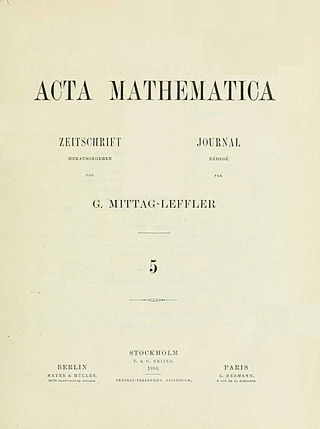
John Forbes Nash, Jr., known and published as John Nash, was an American mathematician who made fundamental contributions to game theory, real algebraic geometry, differential geometry, and partial differential equations. Nash and fellow game theorists John Harsanyi and Reinhard Selten were awarded the 1994 Nobel Memorial Prize in Economics. In 2015, he and Louis Nirenberg were awarded the Abel Prize for their contributions to the field of partial differential equations.

The American Mathematical Society (AMS) is an association of professional mathematicians dedicated to the interests of mathematical research and scholarship, and serves the national and international community through its publications, meetings, advocacy and other programs.

Simon Newcomb was a Canadian–American astronomer, applied mathematician, and autodidactic polymath. He served as Professor of Mathematics in the United States Navy and at Johns Hopkins University. Born in Nova Scotia, at the age of 19 Newcomb left an apprenticeship to join his father in Massachusetts, where the latter was teaching.

The European Mathematical Society (EMS) is a European organization dedicated to the development of mathematics in Europe. Its members are different mathematical societies in Europe, academic institutions and individual mathematicians. The current president is Jan Philip Solovej, professor at the Department of Mathematics at the University of Copenhagen.

Jürgen Kurt Moser was a German-American mathematician, honored for work spanning over four decades, including Hamiltonian dynamical systems and partial differential equations.

Louis Nirenberg was a Canadian-American mathematician, considered one of the most outstanding mathematicians of the 20th century.

Acta Mathematica is a peer-reviewed open-access scientific journal covering research in all fields of mathematics.

William Edward Story was an American mathematician who taught at Johns Hopkins University and Clark University.

The Henri Poincaré Institute is a mathematics research institute part of Sorbonne University, in association with the Centre national de la recherche scientifique (CNRS). It is located in the 5th arrondissement of Paris, on the Sainte-Geneviève Hill.

Arthur Byron Coble was an American mathematician. He did research on finite geometries and the group theory related to them, Cremona transformations associated with the Galois theory of equations, and the relations between hyperelliptic theta functions, irrational binary invariants, the Weddle surface and the Kummer surface. He was President of the American Mathematical Society from 1933 to 1934.

Cédric Patrice Thierry Villani is a French politician and mathematician working primarily on partial differential equations, Riemannian geometry and mathematical physics. He was awarded the Fields Medal in 2010, and he was the director of Sorbonne University's Institut Henri Poincaré from 2009 to 2017. As of September 2022, he is a professor at Institut des Hautes Études Scientifiques.
Francis Dominic Murnaghan was an Irish mathematician and former head of the mathematics department at Johns Hopkins University. His name is attached to developments in group theory and mathematics applied to continuum mechanics.
Thomas Gaskin (1810–1887) was an English clergyman and academic, now known for contributions to mathematics.

Barbara Lee Keyfitz is a Canadian-American mathematician, the Dr. Charles Saltzer Professor of Mathematics at Ohio State University. In her research, she studies nonlinear partial differential equations and associated conservation laws.
Thomas Craig (1855–1900) was an American mathematician. He was a professor at Johns Hopkins University and a proponent of the methods of differential geometry.

Cora Susana Sadosky de Goldstein was an Argentine mathematician and Professor of Mathematics at Howard University.

Clément Mouhot is a French mathematician and academic. He is Professor of Mathematical Sciences at the University of Cambridge. His research is primarily in partial differential equations and mathematical physics.
Florian Luca is a Romanian mathematician who specializes in number theory with emphasis on Diophantine equations, linear recurrences and the distribution of values of arithmetic functions. He has made notable contributions to the proof that irrational automatic numbers are transcendental and the proof of a conjecture of Erdős on the intersection of the Euler Totient function and the sum of divisors function.
Nader Masmoudi is a Tunisian mathematician.













